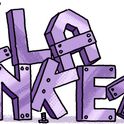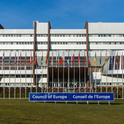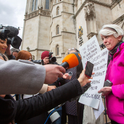"There's CCTV," said the prosecutor cheerfully. I wasn't worried. CCTV is generally of such bad quality that it's hard to figure out what the indistinct blobs on the fuzzy background are doing and to whom. Is it a pub fight? Is it a German expressionistic dance? Is it mating badgers? It's anyone's guess. The prosecutor pressed play. The picture quality was razor-sharp. She turned to me and smiled. "New camera," she said.
Smack bang in the middle of the screen was my client, Giles, outside a pub, stripped to the waist and readying for action. His quarry made a break for it, but was too slow. Giles punched him in the face, flexing his spindly arms at the hidden camera. He might as well have been holding a sign saying "Convict me now." Giles's left hook ignited the whole street corner, with a dozen pub regulars settling their differences like gentlemen.
Crimewatch UK was no match for this footage. It was even better than Cops, the American "real life" television crime show that set the gold standard in the 1990s, with clips of the underclass being righteously clubbed by mustachioed patrolmen. But in these type of programmes, it's always the police and not the defendants who are shown in their best light. And if you thought that only shining examples of police work are caught on camera, you would be, as we barristers like to say, falling into error.
Pondering on how to defend Giles, I remembered Reg, whom I represented at trial on charges of actual bodily harm and affray. Reg first appeared on CCTV stepping out of a police van dressed in flip-flops, a T-shirt and summery shorts—not exactly fighting gear. His hands were cuffed behind his back and he was escorted by two police officers.
What made the CCTV so interesting in this case was the gap between what was in the officers' witness statements and what I—not to mention the jury—could see with our own eyes. The police had claimed that Reg was struggling when he arrived. We could see that he wasn't. The police then alleged that he tried to trip another officer up. It wasn't clear from the tape whether he had or not, but what the arresting officer did next was beyond dispute. He slammed Reg against a wall and then pulled the handcuffs over the back of Reg's head, doubling him over painfully. When asked why, the officer said that he did it to stop him "kicking out." The CCTV was unequivocal: Reg wasn't "kicking out."
The footage showed things getting even livelier in the cells. As soon as they unlocked one of the handcuffs, Reg used his free hand to grab a police officer and swing them around. Every time one cop got loose, he caught another. Having been keen to get him into the cell, the police found themselves now keen to leave. After a long struggle, Reg still held on to one last officer. Another cop re-entered the cell and used his forearm to pin Reg up against the wall by his neck. Reg tried to push back so the cop punched him twice in the face. Stunned, Reg was manoeuvred into a corner of the cell with the cop's arm still pressed against his neck. Reg dipped his head and bit the cop on the shoulder. Pandemonium broke out. Police flooded the cell. Reg was battered to the floor. The police seized their chance to escape, the last officer being yanked out by his belt.
To have any chance of an acquittal, I had to persuade the jury that Reg sinking his teeth into the cop was self-defence. For this to happen, they would have to accept that the police's behaviour had been unlawful. At the very end of the tape I found something helpful: the CCTV showed the riot squad in full regalia entering Reg's cell to take his fingerprints and DNA by force. Faceless state goons versus the lone citizen was just the kind of thing that might push the jury to acquit. But the judge ruled that their entry was irrelevant to the charges and therefore inadmissible in court.
Would the earlier CCTV footage be enough? All Reg could do was put his faith in the jury. Luckily for him, they came back with a verdict of not guilty.
The CCTV looked damning for Giles. There he was, in glorious Technicolor, smacking someone in the face. But then, recalling it had nearly worked for Reg, I diligently watched the whole of the footage. At the very end of the tape, after the film appeared to have ended, the picture flickered back to life. The police were arresting Giles's co-defendant, Dave. An officer pinned Dave up against a shop front, picked him up and slammed him on the floor. When Dave's girlfriend intervened, they slammed her on the floor, too. She tried to get up and the arresting officer pushed her back down with his boot. Here was the"riot squad" moment. Once the other defence lawyers had seen this clip, we demanded that all charges be dropped in return for the couple not pressing charges for excessive force. To my amazement, the prosecution agreed and Giles and his friends were free.
The golden rule of defence is that the less evidence there is, the better—unless, as in this case, it is evidence that contradicts what the prosecution witnesses are claiming under oath. CCTV is often useless but when it works it is like alchemy, turning lead into gold. You just have to sift through every frame to find it.











